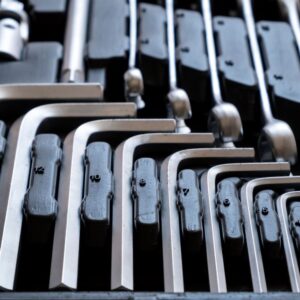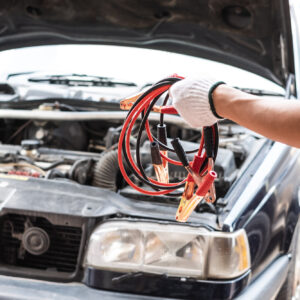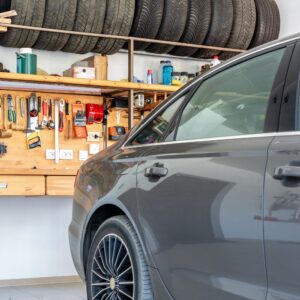Having your own set of tools certainly makes DIY repair and maintenance tasks easier, but even these contraptions will need some help if you want to keep them around for a long time.
Rust is every tool’s worst enemy, and a lot of people tend to give up on cleaning it off their stuff. Fortunately, there are some ways to get around this problem, and they only involve a few simple steps.
How Does Rust Form in the First Place?
Before anything else, it would be helpful to get a good grasp of how rust forms on metal tools. That way, you can avoid dealing with the same problem when working on your vehicle.

Rust is essentially iron oxide. It’s a type of corrosion that forms as a result of oxidation, which is the chemical reaction that takes place when iron reacts with oxygen and water.
Rusting is an electrochemical process that involves the following:
- Anode – any piece of metal that gives up electrons
- Electrolyte – a solvent that moves electrons
- Cathode – another piece of metal that accepts electrons
The electrolyte provides oxygen to the anode as the metal corrodes. Electrons are then freed once oxygen combines with metal.
As the anode flows through the electrolyte and cathode, the metal from the anode disappears. The electrical flow sweeps the anode away or gets converted into cations like rust.
Rust can form on almost any iron-containing metal.
An exception would be stainless steel, which is a versatile alloy made primarily of iron, chromium, and often nickel, along with other elements.
When water comes into contact with an iron object, the water combines with carbon dioxide in the air, forming a weak carbonic acid.
As acid forms, the iron dissolves. The remaining water then breaks down into hydrogen and oxygen particles, with the latter merging with the dissolved iron bond, turning into iron oxide.
How to Get Rust Off of Metal Tools Fast
There are several ways to get rust off your tools, and most of them only require a few items that you can find in your own home. Let’s check out some of these nifty rust-removal tips for your garage tools.
Use the Vinegar and Salt Combo
Salt and vinegar can do more than add some flavor to your favorite meals. This combination also makes a great cleaning solution for rusty tools.
The salt and vinegar combo works best for removing large amounts of rust, including those in hard-to-reach spaces.
- Step 1: Degrease and clean your tools then pat them dry.
- Step 2: Place your tools in a large tub or container where they can be fully submerged.
- Step 3: Pour vinegar into the container until the metal parts of your tools are covered. Sprinkle some salt onto the surface of these tools. Make sure to use 1/4 cup of salt per liter of white vinegar.
- Step 4: Leave the tools submerged in the mixture for between one and three days. It might take a while for the mixture to fully break down the rust, so it’s a good idea to check your tools periodically.
- Step 5: Once the rust has softened, use a metal brush or steel wool to scrub the tools.
- Step 6: Wash, rinse, and dry your tools as needed.
Note: If your tools are too big to fit into a container, wrap them in a vinegar-soaked cloth with salt and seal them in a plastic bag.
Neutralize with Baking Soda
Baking soda is a cleaning agent that works well with vinegar, but it can do the job pretty well on its own. Baking soda is a slightly abrasive cleaning agent that does a fantastic job at dislodging stubborn particles and removing tough stains.
- Step 1: Degrease and clean your tools then pat them dry.
- Step 2: Mix equal parts of water and baking soda in a bowl to form a paste.
- Step 3: Cover your tools with a layer of paste and let the mixture sit for a few hours.
- Step 4: Use a brush to scrub the paste away or simply wipe it off your tools.
- Step 5: Wash, rinse, and dry your tools as needed.
Use Oxalic Acid
Oxalic acid is a type of organic acid that acts as an iron complexing agent that effectively removes rust.
Oxalic acid makes a great rust removal agent because of its ability to form a stable water-soluble salt with ferric iron.
When dealing with oxalic acid, always remember that it’s a harsh chemical that can lead to health and safety issues when mishandled.
- Step 1: Degrease and clean your tools then pat them dry.
- Step 2: Wear a pair of rubber gloves and goggles.
- Step 3: Put your tools in a large container where they can be fully submerged.
- Step 4: Add three tablespoons of oxalic acid per one gallon of water into the container. Mix them carefully and avoid splashing the solution all over your work area.
- Step 5: Let the tools soak for about 20 minutes or according to the oxalic acid’s specifications.
- Step 6: Wash, rinse, and dry your tools as needed.
Sand Your Tools Down
Sometimes, all it takes is a good old sheet of sandpaper to get rid of rust from your tools.
- Step 1: Degrease and clean your tools then pat them dry.
- Step 2: Try to remove as much rust as you can using a steel wool or stiff wire brush.
- Step 3: Remove thick patches of rust using a coarse grit sandpaper. Switch to a finer grain of sandpaper to get rid of fine layers of rust.
- Step 4: Wash, rinse, and dry your tools as needed.
Rust Prevention Methods
Many DIYers try to avoid dealing with rust as much as they can. Having a set of rusty tools can make simple tasks quite difficult to accomplish, so you might want to take care of your tools the next time around.
Conditioning your tools and storing them in a contained space can make all the difference.
Bake Your Tools
To condition your tools, lay them out on a cooling rack on top of a cookie sheet and put them in the oven.
Put the oven on its warm setting and leave the tools to bake for about 10 minutes. Once they’re out of the oven, apply a generous coat of WD-40, using a rag to get the oil into the nooks and crannies of your tools.
Storage Is Key
Always make sure to store your tools in a location with relatively low humidity. If you’re planning to leave them in your garage but the atmosphere is quite humid, you might want to consider leaving a dehumidifier in there as well.
Any information provided on this Website is for informational purposes only and is not intended to replace consultation with a professional mechanic. The accuracy and timeliness of the information may change from the time of publication.





















